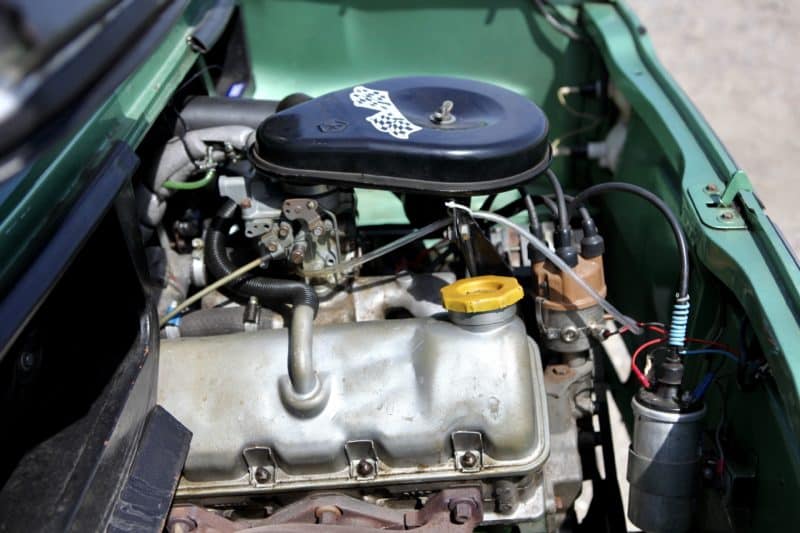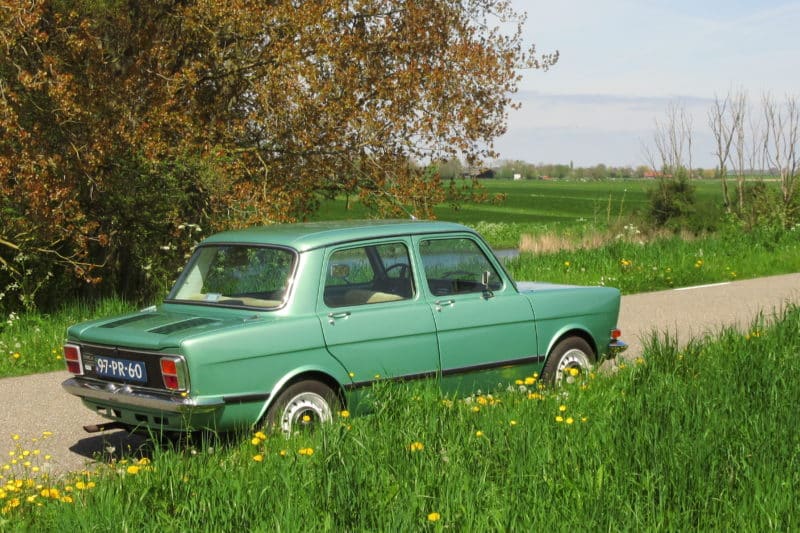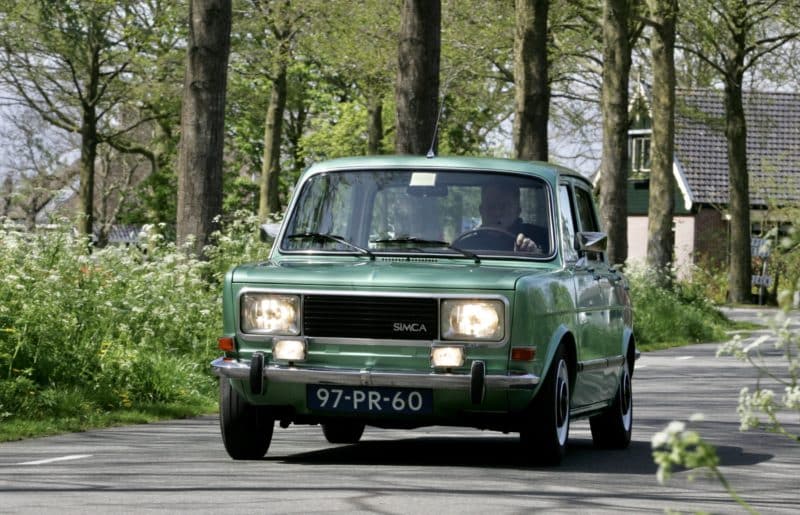In 1976 the Simca 1000 existed for fifteen years. Still, the makers saw enough reason to adapt the successful Frenchman again. The 1000 series was called 1005/1006 and got a new, more rectangular front with ditto headlights. André Reus from Venhuizen has a copy from that modified series: the 1006 SR from March 1977, which was only on the program for one model year after the restyling of the 1000 series. André has owned the car for more than forty years, and years ago gave the car a thorough and cum laude successful restoration.
You will read more about the revival of André's Simca in a while. Now we make room for the driving impressions we gained during the double report with the Simca 1006 SR and the Talbot Samba Cabriolet. The impression about the Talbot will follow later, now the Simca 1006 SR is central. This version was the most luxurious model within the regular 1000 series (we will leave out the Rallye versions), and it received the 1118 cc engine with 54 DIN hp in the rear. Furthermore, the tinted windows, the halogen lighting and the fog lamps caught the eye. The decoration of the wheels was also specific. The interior included furniture with velor upholstery.
If you were looking for a car for just under 1977 grand in 10, you could choose from a decent range with smaller Japanese, Eastern Europeans, Italians and French. The Simca 1006 SR played its own violin within this category. The model was based on the 1000 from 1961. In addition, the concept with the rear engine and wheel drive on that side was no longer common in 1977.
But Simca had other irons in the fire with the 1006 SR. Firstly, Simca could boast of a fairly dense dealer network. In addition, the '1000 concept' had been on the market for sixteen years at the time, and was therefore tested. And in the 1006 SR version, the Simca was nicely equipped and well finished with luxurious materials. An extra asset was that the Simca 1006 SR was the only version within the 1977/1005 series during model year 1006 to have the spicy 1118 cc engine on board. And many competitors were left behind. Nice: for a few hundred guilders more (and also under 10 grand) Simca also had the sporty and larger motorized Simca Rallye 1 in the program.
We are going to drive the Simca 1006 SR. The compact French car reveals a big surprise immediately upon entry. Even with a length of almost two meters you can find a great place behind the wheel without breaking the bank, you are remarkably spacious. And not only that: the velvet-upholstered seats offer a spacious and excellent seat. There is enough space in the back for two children. The Simca 1006 SR offers more surprises. It steers very lightly, but precisely. The trolley is excellent to place. The engine offers the Simca more than enough power, it is very easy to get going. The poker is well within reach, the box with four well-overlapping gears shows little play and works with a rubbery feeling counterpressure. Linking is a piece of cake, although the left wheel arch is a bit in the way.
Short and good. This Simca 1006 SR is really nice to be on the road with. You can see from the active handling why it took the French little effort to do so rally themes on this car. The nice thing about this is that you also notice comfortable traits in this car in the background. On the dike roads with sometimes sharp curves, you notice that oversteer tendencies are absent, especially if you drive normally with the Simca. You do feel very emphatically that the rear axle carries the largest part of the car weight. This is of course due to the technical configuration, which is often associated with crosswind sensitivity.
We cannot appreciate that last character trait, the wind is light and we also avoid a long open and straight stretch during the reporting day. However, owner André Reus says that it is not too bad with the influence of the wind on course stability. “It is a matter of adjusting the speed when the wind is blowing hard. And only when the wind blows very hard does some extra weight go into the luggage compartment in the front. And that also depends on the car occupation. In terms of handling, it also makes a difference whether you are in the Simca with one or four people. The same goes for comfort.”
On a beautiful day in May, the beautifully restored Simca 1006 SR pleasantly surprised. And in such a way that it became clear with retroactive effect why the Simca 1006 SR in 1977 was an excellent alternative within the price range of just under 10.000 guilders. And not only that: the Simca is today a fine and striking driving classic that shows the charms of its historic concept in a characteristic and surprising way.
The images were made by Bart Spijker and Erik van Putten











Kek trolley; very good for slippers id winter 🤪😀
Autovisie has often published very questionable test results. Notorious is an editor (TR) who has let himself be wrapped up and bribed by a Bavarian car brand. It is now the magazine of a newspaper that is not really known for objective journalism.
After to SIMCA or in fact a factory that made FIATs to avoid import tax.
The 1000 series was a technically simple family car that also had tasteful types in French. For example, the Rallye versions were predecessors of the hot-hatches and GTI family cars. Gazelle on the flank and stripes on the derrière, super sporty.
The square headlights were once fashionable, even the 2CV got square lights. I have always experienced that as a disappointment. It really gave more light but doesn't look like it.
In the Autovisie of June 18 that same year, 1977, the intended successor is already mentioned in the form of the Chrysler 424, the later Talbot Samba. In the same article, the FSO Polonez is presented, here still called Fiat Polski.
This Simca was listed for fl. 9.595 in the price lists. Anyone who wanted to spend such an amount on a comfortable and economical four-door passenger car could, in addition to this somewhat old-fashioned 1006, choose from a Citroën 2CV or Dyane of all versions, the Fiat 127 four-door, a Lada 1200S, a Renault 4L a Skoda 120LS, the Zastava 1100 five-door. So no Japanese, they could only offer two-door city cars under fl. 10.000.
Without a doubt the frontrunner in terms of model and technology was the Zastava, based on the front-wheel drive Fiat 128 but with a handy fifth door. The Fiat 127 with its front-wheel drive was also modern, compact but no smaller than the Simca in terms of interior space. The Skoda 120LS was more spacious and a lot more luxurious and the model was brand new, but the technology underneath was just as old as that of the Simca. So was the Renault, not to mention the Citroëns. The Lada 1200S was based on the Car of the Year from ten years earlier, the Fiat 124, and besides offering more space than the Simca, it was a hell of a towing car for every caravan owner.
It also continues to amaze me that the Skoda 120L was labeled "dangerous" by the same Autovisie in June 1977, because of the rear engine in combination with pendle axles, but that no one has ever used those words with this Simca with comparable technology. In any case, the driving characteristics did not differ and it resulted in a fine legal battle for Autovisie with Skoda importer De Binckhorst.
Thanks for the detailed response. I've seen the price lists. The text does not explicitly mention the four-door competitors, but about cars that were just under 10 grand at the time. Within that spectrum you could also go to Mazda, Toyota and Datsun. They were indeed competitors, the migration to the Japanese had been well under way for some time. The story of the Skoda in Autovisie (June 4, 1977) was regrettable, I have that particular issue.
Got my driver's license. Always had a soft spot for that car. A kind of first love, I would say.
it almost became the fiat 850…
A beautifully restored Simca 1006
Everything in this car is new